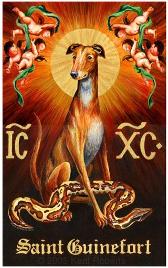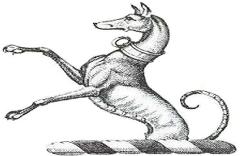


|
Saint Guinefort |
|
Translation [This is from a printed text, but I only two xeroxed pages, and no record of the author. There was an online version at Paul Hyamn's pages at Cornell, but that seems to have disappeared. I am cc'ing this to a couple of other lists in order to see if any one recognizes the source! Although after my recent effort to get people to talk about Alexius I and Robert of Flanders' I am not sure anyone is interested in texts!] Stephen of Bourbon (Etienne de Bourbon) (died about 1262): De Supersticione: On the Worship of the Dog Guinefort Sixthly, I should speak of offensive superstitions, some of which are offensive to God, others to our fellow men. Offensive to God are those which honour demons or other creatures as if they were divine: it is what idolatry does, and it is what the wretched women who cast lots do, who seek salvation by worshipping elder trees or making offerings to them; scoming churches and holy relics, they take their children to these elder trees, or to anthills, or to other things in order that a cure may be effected. This recently happened in the diocese of Lyons where, when I preached against the reading of oracles, and was hearing confession, numerous women confessed that they had taken their children to Saint Guinefort. As I thought that this was some holy person, I continued with my enquiry and finally learned that this was actually a greyhound, which had been killed in the following manner. In the diocese of Lyons, near the enclosed nuns' village called Neuville, on the estate of the Lord of Villars, was a castle, the lord of which and his wife had a baby boy. One day, when the lord and lady had gone out of the house, and the nurse had done likewise, leaving the baby alone in the cradle, a huge serpent entered the house and approached the baby's cradle. Seeing this, the greyhound, which had remained behind, chased the serpent and, attacking it beneath the cradle, upset the cradle and bit the serpent all over, which defended itself, biting the dog equally severely. Finally, the dog killed it and threw it well away from the cradle. The cradle, the floor, the dog's mouth and head were all drenched in the serpent's blood. Although badly hurt by the serpent, the dog remained on guard beside the cradle. When the nurse came back and saw all this she thought that the dog had devoured the child, and let out a scream of misery. Hearing it the child's mother also ran up, looked, thought the same thing and screamed too. Likewise the knight, when he arrived, thought the same thing and drew his sword and killed the dog. Then, when they went closer to the baby they found it safe and sound, sleeping peacefully. Casting around for some explanation, they discovered the serpent, tom to pieces by the dog's bites, and now dead. Realising then the true facts of the matter, and deeply regretting having unjustly killed so useful a dog they threw it into a well in front of the manor door, threw a great pile of stones on top of it, and planted trees beside it, in memory of the event Now, by divine will, the manor was destroyed and the estate reduced to a desert,* was abandoned by its inhabitants. But the peasants, hearing of the dog's conduct and of how it had been killed, although innocent, and for a deed for which it might have expected praise, visited the place, honoured the dog as a martyr, prayed to it when they were sick or in need of something, and many there fell victim to the enticements and illusions of the devil, who in this way used to lead men into error. Above all, though, it was women with sick or weak children who took them to this place. They would go and seek out an old woman in a fortified town a league distant and she taught them the rituals they should enact in order to make offerings to demons, and in order to invoke them and she led them to the place. When they arrived, they would make offerings of salt and other things; they would hang their babies' swaddling-clothes on the bushes roundabout: they would drive nails into the trees which had grown in this place; they would pass the naked babies between the trunks of two trees the mother, on one side, held the baby and threw it nine times to the old woman, who was on the other side. Invoking the demons, they called upon the fauns in the forest of Rimite to take the sick, feeble child which, they said, was theirs, and to return their child that the fauns had taken away, fat and well, safe and sound. Having done this, the infanticidal mothers took their children and laid them naked at the foot of the tree on straw from the cradle; then, using the light they had brought with them, they lit two candies, each an inch long, one on each side of the child's head and fixed them in -the trunk above it. Then they withdrew until the candles had burnt out, so as not to see the child or hear him crying. Several people have told us that while the candies were burning like this they burnt and killed several babies. One woman also told me that she had just invoked the fauns and was withdrawing from the scene when she saw a wolf come out of the forest towards the baby. If maternal love had not made her feel pity and go back for him, the wolf, or as she put it, the devil in the shape of a wolf, would have devoured the baby. When a mother returned to her child and found it still alive, she carried it out into the fast-flowing waters of a nearby river, called the Chalaronne [a tributary of the Sa6nel, and plunged it in nine times; if it came through without dying on the spot. or shortly afterwards, it had a very strong constitution. We went to this place, we called together all the people on the estate, and we preached against everything that had been said. We had the dead dog disinterred, and the sacred wood cut down and burnt, along with the remains of the dog. And 1 had an edict passed by the lords of the estate, warning that anyone going thenceforth to that place for any such reason would be liable to have his possessions seized and then sold. END
*The O.E.D. gives'an uninhabited and uncultivated tract of country; a wilderness: a. now conceived as a desolate, barren region, waterless and treeless. and with but scanty growth of herbage. . . b. formerly more widely applied to any wild, uninhabited region, including forest-land.' It is in the latter sense that the word is employed here. Tr.
COMMENT: Although this document has been available to scholars for a hundred years it has never previously been fully studied. Graus, the great historian of early medieval hagiography, mentions it in a footnote, but his book, outstanding though it is, is grounded in a set of concerns and a methodology which prevents him from making fuller use of it. Most of the references to this document are by folklorists; some, notably Baring-Gould in England and Saintyves in France, are interested exclusively in the narrative of the dog's death, which they compare to similar narratives in medieval literature or in more recent popular literature. and some literary historians, Gaston Paris in particular. have shared this approach. Other folklorists have concentrated their attention upon the child-healing rite, so as to demonstrate the antiquity of ritual practices still surviving in the countryside. Finally, local historians have seen the text as a picturesque illustration of the'primitivism' which has long been attributed to the inhabitants of the Dombes. Very few have sought to give this document the thorough investigation that it deserves." One can perhaps account for this silence, and for the inadequate treatment that this document has received in the last hundred years, in terms of a fundamentally ideological reluctance to admit that such a cult could have existed. One could also invoke the general positivism of the period, and the lack of contact between disciplines. This new attempt at an interpretation has not come about by chance, however, but is the outcome of a collective enquiry into the literature of exempla, the narrative genre to which this document belongs. This enquiry is itself part of a broad current of research into 'popular literature', 'oral traditions'. 'popular culture' 'popular religion' and so on. I do not propose, however, to survey the various and often contradictory approaches that these expressions cover," nor even to situate my own work in relation to them. My approach and methodology will become clear as I proceed with the analysis of the text. Meanwhile, I shall simply set out the main questions that the text raises, and try to explain how I think one might answer them. There is one question that is in urgent need of an answer. It concerns the relationship between the two cultures, one of which is literate, Latinate, urban, clerical, responsible for Christian orthodoxy, drawing its strength from its powers of temporal and spiritual coercion, and which produced this text, the other of which is popular (in the limited, sociological sense of the word), oral, vernacular, peasant, secular, Christian also (although in a different sense), and which, in the text, is the object of both a description and a repression. I shall follow the conventional usage, and call the former 'learned culture' and the latter 'folk culture'. (The advantage of this latter term is that it avoids the ambiguities attached to the term'popular, although it admits those attached to the term 'folk', or to 'folklore'.) However, regardless of the customary use of the term ('folk'/'folklore'), my choice of 'folk culture' clearly situates the present work within a scientific anthropological perspective.
ANOTHER VERSION in ref The Sorceress. Le Moine et la sorcière, aka The Sorceress France (1987): Historical/Drama, 97 minutes. Director: Suzanne Schiffman; Cast includes Tchéky Karyo and Christine Boisson The Sorceress was written by a professional Medieval scholar - Pamela Berger of Boston College - and was shot in both French and English. It is based on a genuine medieval text by the 13th-century Dominican, Etienne de Bourbon, about the cult of St. Guinefort near Lyons in France. St. Guinefort (probably derived from "Cynephoros" in Greek, sometimes a name for St. Christopher) was a sainted greyhound! The story, which is slow but involving, focuses accurately on early 13th century historical issues: the survival of "folk" culture; the role of women; the beginnings of the Dominican order; the use of profit-based farming techniques (in this case carp ponds) by local nobilities. The actors are professional, and the story has interesting twists. A very good film for classroom use.
Source. Anecdotes historiques…d'Étienne de Bourbon, ed. A. Lecoy de Marche (Librairie Renouard: Paris, 1877), 314-29. Translated (by Paul Hyams?) at http://falcon.arts.cornell.edu/~prh3/262/texts/Guinefort.html. This text is part of the Internet Medieval Source Book. The Sourcebook is a collection of public domain and copy-permitted texts related to medieval and Byzantine history. Unless otherwise indicated the specific electronic form of the document is copyright. Permission is granted for electronic copying, distribution in print form for educational purposes and personal use. If you do reduplicate the document, indicate the source. No permission is granted for commercial use. © Paul Halsall, September 8, 2000 |

Medieval Sourcebook:
|